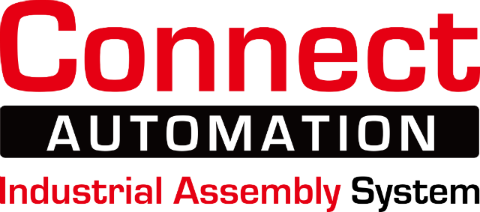PT. Environeer
031-99858624 (Surabaya), 021-8935060 (Jakarta)
Increasing Production Capacity Using The Best Roller Conveyor
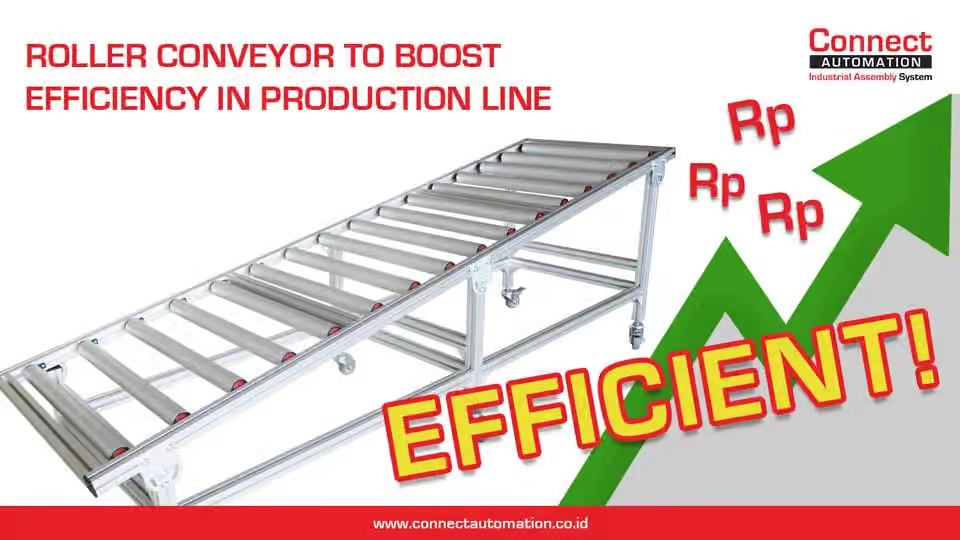
Use of roller conveyor in production line increases efficiency significantly in industrial environment. You would need to understand things about roller conveyor before you can choose and apply it within your production line.
This article will go through every things about roller conveyor and how it works within production lines.
Definition of Roller Conveyor
Roller conveyor is one of many conveyor types that consists of multiple rollers assembled within its frame. These conveyor rollers can be moved using motorised energy or by using the graviational energy.
It is recommended that the product or materials transferred to have a solid surfaces so it would slide on top of the roller conveyor. Roller conveyors are highly compatible to move products which are already packaged inside a cardboard box.
Roller conveyor shapes are more dynamic compared to that of a belt conveyor. Not only incline or decline, roller conveyor also supports 90 – 180 degrees turn to better fit the area that it’s being used in.
Roller Conveyor’s Important Parts
There are 3 important parts in a roller conveyor that you need to pay close attention to. Those parts consists of rollers, frame and the legs.
Rollers
This cylinder shaped rollers can be manufactured out of stainless steel, aluminium and also steel. Select which material for your rollers based on the type and how heavy is the material that would be transferred.
Roller conveyors have a mininum width of 100mm and can span up to 600mm. The width of these rollers can be used to transfer more products or materials which increases efficiency of moving products to different stations. Moreover, the axis diameter and roller can be adjusted to support product’s weight.
Frame
Frame is one of the most important parts for a conveyor. You can use aluminium profile, stainless steel or steel for its frame material.
Conveyor’s frame works as a holder for rollers to keep them at bay and move around. Roller’s axis fastened and fitted into a hole on the conveyor frame to keep the axis from turning when product transfer is in progress.
You may also add side guides, chutes, small desk, slot cover or even sensors on any part of the frame that you needed. Side guides works to keep materials on top of conveyor.
Support Foot
Foot on a conveyor ease assembly of the frame when assembling rollers and can also hold the weight of its own frame. Conveyor’s foot can be that of adjustable foot and you can also add more parts such as wheels or floor anchoring.
Roller Conveyor Type
There are some types of roller conveyor commonly used ini varieties of industry. Let’s walk you down through some of roller conveyor types and its practicality in production line.
Roller conveyor types are gravity roller conveyor, belt driven roller conveyor, chain driver roller conveyor and heavy duty roller conveyor.
Gravity Roller Conveyor
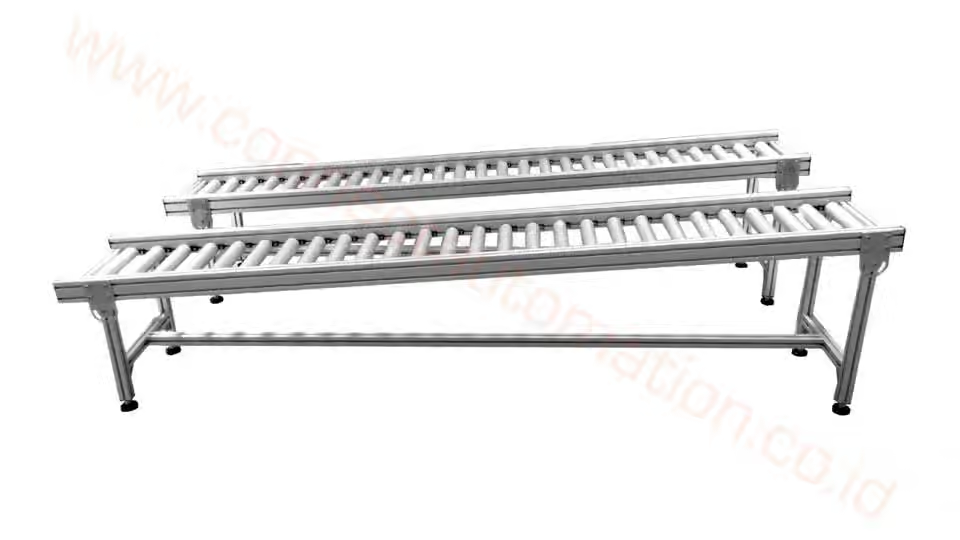
Gravity Roller Conveyor by Connect Automation
Gravity roller conveyor uses gravitational force to move products or material and because of it, all gravity roller conveyors are declining in height from initial point to output point.
This roller conveyor consists of only the frame and support legs. Side guides are optional based on type and size of products to transfer.
There are multiple features that can be added to better fit what required on the field. Adding a pop up stop, desk at the end of conveyor or a karakuri system designed roller conveyor can be done as well.
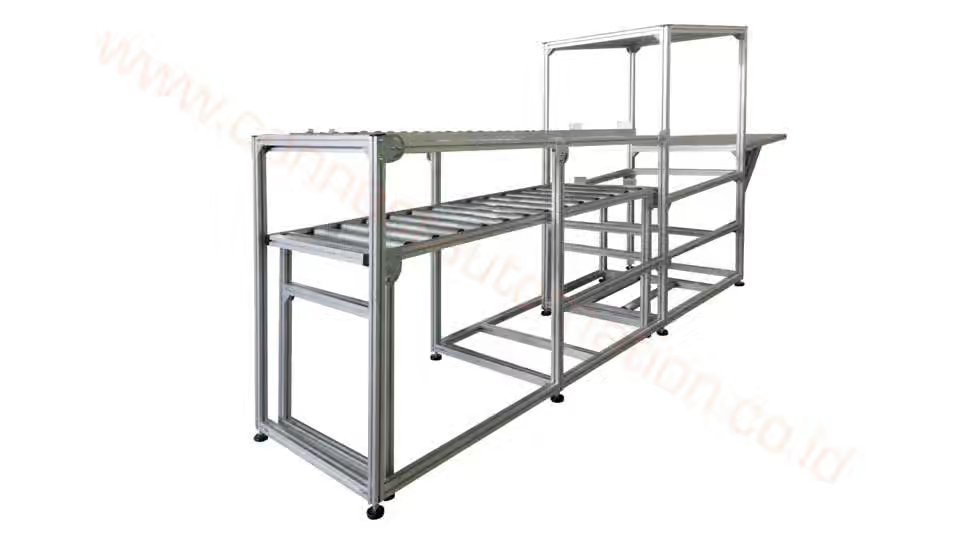
Karakuri Roller Conveyor by Connect Automation
Gravity roller conveyor increases product transfer speed especially on an unloading processes. For variants like karakuri roller conveyor can be applied to increase efficiency on moving products between stations.
Belt Driven Roller Conveyor
Belt driven roller conveyor take advantage of belt with powered motor to move every single roller. This type of conveyor simplify how you control material or product movements that are being transferred.
This type of conveyors are commonly have a flat and long shape which makes this belt driven roller conveyor more compatible for long range material transfers.
Things to be considered when about to use belt driven roller conveyor are room humidity, overheating and dust particles which can stick to the belt drive and reduce conveyor’s overall performance.
Belt driven roller conveyor simplify material transfer with medium and up to heavy load on a dry and clean condition. This conveyors are commonly used in a production line which requires material to stop at one specific point and then back again to initial point.
Chain Driven Roller Conveyor
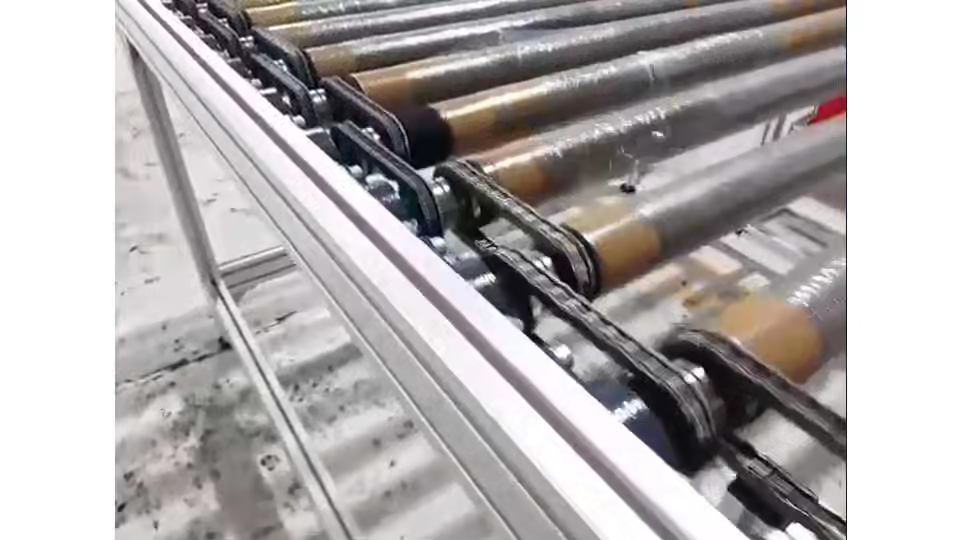
Chain Driven Roller Conveyor by Connect Automation
This type of roller conveyors have no big differences from the previous belt driven roller conveyor, they both uses powered motor. It’s just that this type of conveyor uses chain as the roller drivers and not belt.
Its roller drivers uses chain which enabled conveyor to transfer heavy weight materials. Therefore this conveyor offers high efficiency on tasks that requires back and forth movement with heavy load.
Lineshaft Roller Conveyor
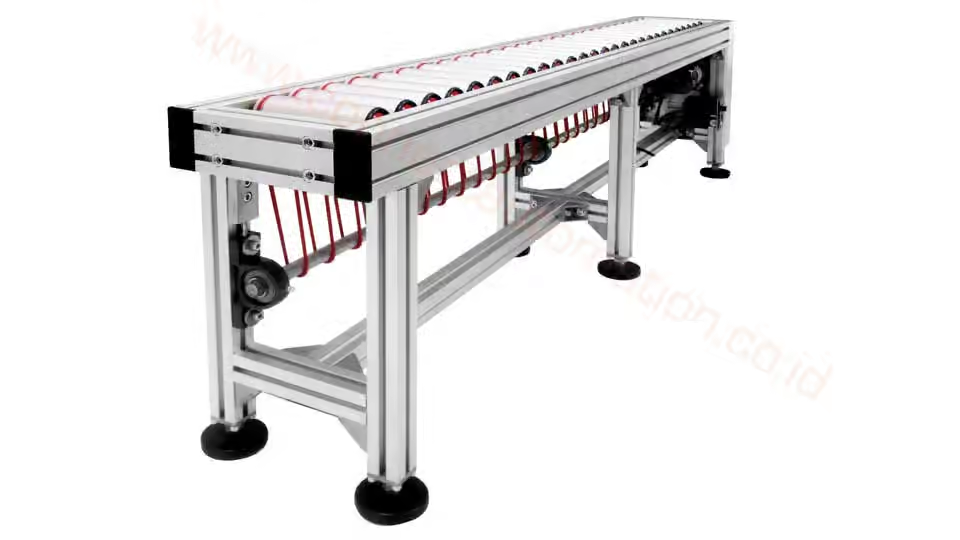
Lineshaft Roller Conveyor by Connect Automation
Lineshaft roller conveyor uses lineshaft system which help spins every roller on the conveyor. The use of spools drive and urethanen belt on this conveyor makes it easy for maintenance and result in a more stable day to day usage.
This conveyor highly compatible for sorting tasks with light to medium load. Lineshaft roller conveyor can also move both forward and backward based on what your production line needed.
Selecting Conveyor Specifications
There are things to consider before you jump ahead and decide which roller conveyor that you would want to use.
Here are some spesifications that you need to pay close attention at before selecting a conveyor that would increase your production line efficacy.
Material’s Characteristics to be Transferred
First and foremost specification on determining your type of roller conveyor is to know your product or material’s characteristics. Besides the clear factor which is weight, you also need to know any special characteristics of the materials such as oily, sharp or hot.
When you understand your material’s characteristics in more detail, it would be far easier to select which type of roller conveyor that you can use and right for you.
Roller and Frame Materials
Next one is your roller and conveyor frame materials. This specifications are, too, need to be adjusted to your material’s characteristics.
Conveyor frame material varies and each one has certain characteristics, as for the roller material itself is still varying because rollers come in direct contact with the product that you are moving.
You should also choose roller’s material based on the needs to keep product’s quality high.
The same concept applies to selection of frame’s material. Choose the one material for your frame that can support the weight of the rollers and materials.
Room Size and Condition
Room size and condition sets limitation on the length, shape and type of roller conveyor that you would use. Is it short range or long range? Should you need any vertical movement of products?
Take for example that you want to move 70kg materials through a distance of 10 meters and your floor surface is not quite flat. For that case you would need to use chain driven roller conveyor along with adjustable foot to better place the conveyor on top of a rough surface.
Control System
The last one is control system for roller conveyor. You need to make sure what movement range that you need for the materials moved.
If material moved needs to go back to initial point, then you would need a two ways control system. Roller conveyor with two ways control will increase time efficiency and save manpower especially in moving things.
Summary
Roller conveyor can be used in almost every industrial field such as food and beverages, chemical, pharmaceutical, packaging, automotive, plastic manufacturing, cosmetics to delivery or industries.
You can increase your production line efficiency just with clear understanding of what every types of roller conveyor do so you can choose the best conveyor for you that supports your industry. Did you know that production line is not the only thing that can be improved? You can also improve your own personal efficiency by following these 3 simple steps to increase productivity.
Contact Connect Automation to get any Roller Conveyors that are highly compatible within your industry’s production line.
